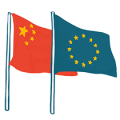

Central and Eastern Europe and Joint European China Policy: Threat or Opportunity?
The relationship of Central and Eastern Europe member states to Beijing is seen by many as a hindrance to a unified EU approach to China. But is this view justified? Grzegorz Stec looks at the facts.
“Unity is vital in every area of our relationship with Beijing because no European country is, on its own, capable of defending its interests and values against a country the size and might of China.“ So wrote Josep Borrell, the EU’s High Representative, in a recent article elaborating on the “Sinatra Doctrine”, a loose concept intended to describe the EU’s approach to China.
The need for unity is widely recognized and is an important point on the agenda of the special European Council summoned by President Charles Michel this week. It is hoped that a common stance can be reached ahead of the EU27-China Summit, now expected to take place in Brussels in 2021. But one of the challenges, if approached correctly, could turn out to be an opportunity.
A Trojan horse?
China’s activity in Central and Eastern Europe (CEE) – and the 17+1 initiative, in particular – have long been portrayed as an example of China’s ability to undermine European unity through the “divide and conquer” strategy. The narrative holds that by leveraging the regional platform, China has been able to extract political favors from CEE countries (including EU member states in the region) in exchange for economic benefits – primarily investments. The 17+1 has effectively been regarded as a “Trojan horse” within the European keep.
However, eight years on from the establishment of the 17+1 (then 16+1), this narrative does not hold ground. Not only that, the misconceptions around it undermine European unity by alienating 12 member states participating in the framework (11 CEE states and Greece) through labelling them as disruptive to EU-China relations.
The truth is that China’s offer – like its regional diplomacy targeting developing countries – has proven ill-suited for the EU member states among CEE countries. Despite the region’s considerable need for investment in infrastructure, the credit-based offer from China, with strings attached, has not been attractive to member states that otherwise benefit from access to EU instruments or can seek to acquire capital from more transparent American or Japanese sources. The prospect of confronting legal and political hurdles – like the European Commission’s 2017 probe into the Hungarian section of the Belgrade-Budapest railway – has been a further turn-off.
Consequently, Chinese investments in the 12 EU member states participating in 17+1 remain modest, amounting to EUR 8.6 billion between 2010 and 2019. In comparison, over this same period China invested more in Finland (EUR 12 billion) or the Netherlands (EUR 10.2 billion).
Words and actions
Although very diverse, the CEE EU states share a sense of disillusion with China due to the mismatch between its economic promises and ultimate outcomes. Indeed, one of the staunchest proponents of engagement with Beijing – Czech President Miloš Zeman – announced in January 2020 that he would not attend this year’s 17+1 Summit despite the plan for it to be presided by President Xi Jinping. “I don’t think the Chinese side has done what it promised. I’m talking about investments,” he said to Czech media. Although Zeman later backtracked, this shows that even Beijing’s biggest supporters have been discouraged.
Actions, of course, speak louder than words, and here, too, the evidence of disillusionment is gathering. In the absence of significant economic stakes, many of the CEE countries have been open to sacrificing relations with Beijing for other objectives – security and political ones.
For instance, given Russia’s growing activity, some have chosen to leverage the Sino-American rivalry to help ensure the US administration’s commitment to NATO in the region. It is notable that every one of the EU countries that signed the 5G memorandum targeting Huawei with the US, is from the CEE (Czech Republic, Estonia, Latvia, Lithuania, Poland, Romania, Slovenia). Polish authorities moved to draft some of the harshest regulations on 5G, proposing excluding infrastructure providers from countries with poor human rights record.
Romania, meanwhile, is revising its agreement with state-owned China General Nuclear for the construction of two nuclear reactors on security consideration grounds. Similarly, in Estonia plans to build an underwater tunnel connecting Tallinn and Helsinki have been halted over security concerns about the involvement of Chinese SOEs.
In the case of the Czech Republic, relations with China have become a matter of domestic politics. The recent visit to Taiwan by the President of the Czech Senate Miloš Vystrčil came just a month before the regional and Senate elections in the country and has helped his opposition party to build political capital on a values-based approach to foreign policy, in contrast to President Zeman’s pro-Beijing stance.
It is telling that in the recent diplomatic visits to Europe, US Secretary of State Mike Pompeo toured CEE, whereas Chinese Foreign Minister Wang Yi and Director of the CCP’s Central Foreign Affairs Commission Yang Jiechi did not visit any of the CEE countries (albeit Yang did visit Greece). The next 17+1 Summit remains unscheduled.
Unity among stakeholders
That is not to say that China’s influence within the CEE member states – achieved primarily through personal ties – does not require scrutiny. The case of Viktor Orbán’s Hungary comes to mind. Not only does he leverage the relations with China in the context of his “illiberal democracy” project, but there are also considerable suspicions regarding the involvement of one of his associate’s consortium in the implementation of the Hungarian section of the Belgrade-Budapest railway, which was funded through a loan from China.
However, the broad-brush narrative of China’s influence over the CEE EU member states remains counterproductive. Instead of branding the CEE countries a threat to unity, Brussels should treat those 12 member states as potential stakeholders within the new, united China strategy.
As the former Polish Minister of Foreign Affairs and MEP Radosław Sikorski said during a recent conference at MERICS: “Western Europeans have their longstanding commercial relationships with China […] and they are not letting us, Central Europeans into those relationships […]. Perhaps it [17+1] should be phased out, but on one condition – that the rest of the European Union starts abiding by the Lisbon Treaty and conducts policy towards China in common.”
Brussels should capitalize on such tendencies and bring more voices from the CEE into discussions on China. CEE countries are open to becoming more assertive, but they need encouragement. One way to do this would be to focus more on SMEs, as these form the backbone of CEE countries’ economies. If joint EU policy supported SME interests in China, this would create an incentive for CEE countries to support the joint policy – and turn what some see as a threat to unity into an opportunity.

